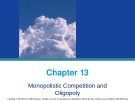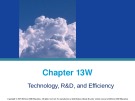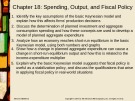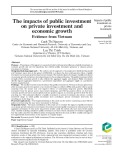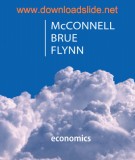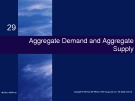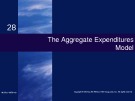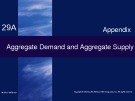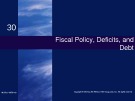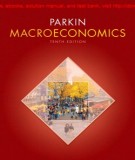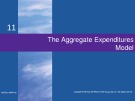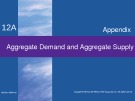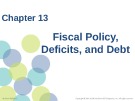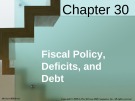
The aggregate expenditures model
-
The aim of this paper is to construct an Augmented Dynamic Model of Job Creation for Malaysian Manufacturing Sector. The previous studies on job creation model focus on the static model where the job creation influenced by real wages, real output, assets, expenditure of research and development (R&D), lag of R&D, export and foreign labour. However, the aggregate rate of unemployment in Malaysia could not explain the dynamic of labour market. The dynamic of labour market can be explained more precisely through the formula of job flows (including job creation and job destruction).
 5p
5p  longtimenosee10
longtimenosee10
 26-04-2024
26-04-2024
 1
1
 1
1
 Download
Download
-
Lecture Macroeconomics in context: A European perspective - Chapter 13: Aggregate supply, aggregate demand, and inflation: Putting it all together. In this chapter you will learn: Aggregate expenditure and inflation, capacity and the aggregate supply curve, putting the AS/AD Model to Work, competing theories.
 58p
58p  runordie1
runordie1
 10-05-2022
10-05-2022
 9
9
 1
1
 Download
Download
-
Chapter 22 - Spending, output, and fiscal policy. After completing this unit, you should be able to: Identify the key assumptions of the basic Keynesian model and explain how this affects firms' production decisions; discuss the determination of planned investment and aggregate consumption spending and how these concepts are used to develop a model of planned aggregate expenditure; analyze how an economy reaches short-run equilibrium in the basic Keynesian model, using both numbers and graphs,…
 46p
46p  tradaviahe15
tradaviahe15
 23-02-2021
23-02-2021
 16
16
 1
1
 Download
Download
-
Chapter 11 - The aggregate expenditures model. The chapter begins with the simple version of the AE model: that of a closed, private economy. The equilibrium GDP is determined and multiplier effects are briefly reviewed. The simplified “closed” economy is then “opened” to show how it would be affected by exports and imports.
 12p
12p  nanhankhuoctai10
nanhankhuoctai10
 23-07-2020
23-07-2020
 18
18
 3
3
 Download
Download
-
Chapter 13 - Fiscal policy, deficits, and debt. This chapter explores the tools of government stabilization policy in terms of the aggregate demand-aggregate supply (AD-AS) model. Next, this chapter examines fiscal policy measures that automatically adjust government expenditures and tax revenues when the economy moves through
 20p
20p  nanhankhuoctai10
nanhankhuoctai10
 23-07-2020
23-07-2020
 16
16
 1
1
 Download
Download
-
This chapter explores the tools of government stabilization policy in terms of the aggregate demand-aggregate supply (AD-AS) model. Next, this chapter examines fiscal policy measures that automatically adjust government expenditures and tax revenues when the economy moves through the business cycle phases.
 17p
17p  nanhankhuoctai10
nanhankhuoctai10
 23-07-2020
23-07-2020
 11
11
 1
1
 Download
Download
-
Chapter 18 - Spending, output, and fiscal policy. After completing this unit, you should be able to: Identify the key assumptions of the basic Keynesian model and explain how this affects firms' production decisions; discuss the determination of planned investment and aggregate consumption spending and how these concepts are used to develop a model of planned aggregate expenditure; analyze how an economy reaches short-run equilibrium in the basic Keynesian model, using both numbers and graphs,…
 20p
20p  nanhankhuoctai10
nanhankhuoctai10
 23-07-2020
23-07-2020
 20
20
 2
2
 Download
Download
-
The authors use the approach of autoregressive distributed lag model and Vietnam’s macro data in the period of 1990-2016, to evaluate the short and long-term effects of public investment on economic growth and private investment. The model evaluates the impact of public investment on economic growth and private investment based on the neoclassical theories. The public investment which strongly affects economic growth is also reflected by aggregate supply and demand.
 18p
18p  nguathienthan5
nguathienthan5
 03-06-2020
03-06-2020
 23
23
 0
0
 Download
Download
-
(BQ) Continued part 1, part 2 of Principles, problems, and policies of economics (Twentieth edition) has contents: The aggregate expenditures model, basic macroeconomic relationships, aggregate demand and aggregate supply, interest rates and monetary policy, financial economics,... and other contents. Invite you to refer.
 644p
644p  thuongdanguyetan04
thuongdanguyetan04
 25-07-2019
25-07-2019
 31
31
 2
2
 Download
Download
-
After reading this chapter, you should be able to: Define aggregate demand (AD) and explain the factors that cause it to change; define aggregate supply (AS) and explain the factors that cause it to change; discuss how AD and AS determine an economy's equilibrium price level and level of real GDP; describe how the AD-AS model explains periods of demand-pull inflation, cost-push inflation, and recession; identify how the aggregate demand curve relates to the aggregate expenditures model.
 22p
22p  dien_vi03
dien_vi03
 08-10-2018
08-10-2018
 32
32
 1
1
 Download
Download
-
In this chapter, students will be able to understand: Illustrate how economists combine consumption and investment to depict an aggregate expenditures schedule for a private closed economy, analyze how changes in equilibrium real GDP can occur in the aggregate expenditures model and describe how those changes relate to the multiplier, identify and describe the nature and causes of "recessionary expenditure gaps" and "inflationary expenditure gaps".
 14p
14p  dien_vi03
dien_vi03
 08-10-2018
08-10-2018
 24
24
 0
0
 Download
Download
-
After completing this chapter, students will be able to: Describe how the aggregate demand-aggregate supply model explains periods of demand-pull inflation, cost-push inflation, and recession; identify how the aggregate demand curve relates to the aggregate expenditures model.
 3p
3p  dien_vi03
dien_vi03
 08-10-2018
08-10-2018
 25
25
 1
1
 Download
Download
-
This chapter explores the tools of government stabilization policy in terms of the aggregate demand-aggregate (AD-AS) model. Next, the chapter examines fiscal policy measures that automatically adjust government expenditures and tax revenues when the economy moves through the business cycle phases. The recent use and resurgence of fiscal policy as a tool are discussed, as are problems, criticism, and complications of fiscal policy.
 18p
18p  dien_vi03
dien_vi03
 08-10-2018
08-10-2018
 24
24
 0
0
 Download
Download
-
(bq) part 2 book "macroeconomics" has contents: money, the price level, and inflation; the exchange rate and the balance of payments; aggregate supply and aggregate demand; expenditure multipliers - the keynesian model; fiscal policy, international trade policy,...and other contents.
 238p
238p  bautroibinhyen23
bautroibinhyen23
 02-04-2017
02-04-2017
 46
46
 3
3
 Download
Download
-
After reading this chapter, you should be able to: Illustrate how economists combine consumption and investment to depict an aggregate expenditures schedule for a private closed economy, discuss the three characteristics of the equilibrium level of real GDP in a private closed economy, analyze how changes in equilibrium real GDP can occur in the aggregate expenditures model and describe how those changes relate to the multiplier,...
 14p
14p  hihihaha5
hihihaha5
 03-01-2017
03-01-2017
 47
47
 1
1
 Download
Download
-
Upon completion of this lesson, the successful participant will be able to: Identify how the aggregate demand curve relates to the aggregate expenditures model; describe how the AD-AS model explains periods of demand-pull inflation, cost-push inflation, and recession.
 3p
3p  hihihaha5
hihihaha5
 03-01-2017
03-01-2017
 42
42
 1
1
 Download
Download
-
Chapter 13 - Fiscal policy, deficits, and debt. This chapter explores the tools of government stabilization policy in terms of the aggregate demand–aggregate supply (AD-AS) model. Next, this chapter examines fiscal policy measures that automatically adjust government expenditures and tax revenues when the economy moves through the business cycle phases.
 24p
24p  nhanmotchut_5
nhanmotchut_5
 02-11-2016
02-11-2016
 29
29
 1
1
 Download
Download
-
Chapter 29 - Aggregate demand and aggregate supply. This chapter define aggregate demand (AD) and explain the factors that cause it to change; define aggregate supply (AS) and explain the factors that cause it to change; discuss how AD and AS determine an economy's equilibrium price level and level of real GDP; describe how the AD-AS model explains periods of demand-pull inflation, cost-push inflation, and recession; identify how the aggregate demand curve relates to the aggregate expenditures model.
 29p
29p  tangtuy08
tangtuy08
 21-04-2016
21-04-2016
 33
33
 2
2
 Download
Download
-
Chapter 28 - The aggregate expenditures model. In this chapter, you will learn to: Aggregate expenditures for a private closed economy, characteristics of equilibrium real GDP in a private closed economy, changes in equilibrium real GDP and the multiplier, adding the government and international sectors, recessionary and inflationary expenditure gaps.
 23p
23p  tangtuy08
tangtuy08
 21-04-2016
21-04-2016
 35
35
 1
1
 Download
Download
-
Chapter 30 - Fiscal policy, deficits, and debt. This chapter explores the tools of government stabilization policy in terms of the aggregate demand-aggregate (AD-AS) model. Next, the chapter examines fiscal policy measures that automatically adjust government expenditures and tax revenues when the economy moves through the business cycle phases. The recent use and resurgence of fiscal policy as a tool are discussed, as are problems, criticism, and complications of fiscal policy.
 25p
25p  tangtuy08
tangtuy08
 21-04-2016
21-04-2016
 41
41
 2
2
 Download
Download
CHỦ ĐỀ BẠN MUỐN TÌM













